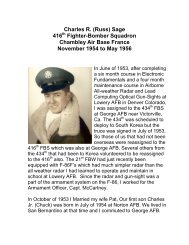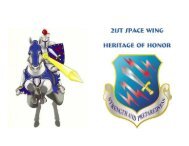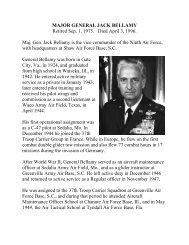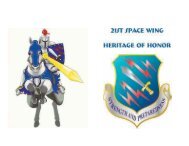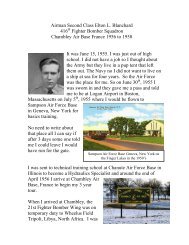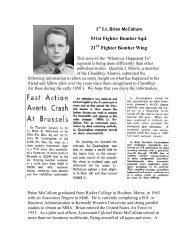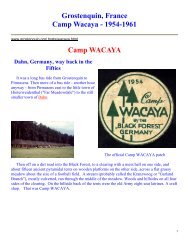Chambley Air Base France Home Pages
Chambley Air Base France Home Pages
Chambley Air Base France Home Pages
You also want an ePaper? Increase the reach of your titles
YUMPU automatically turns print PDFs into web optimized ePapers that Google loves.
CHAMBLEY AIR BASE<br />
By Jean-Pierre HOEHN<br />
Note: The first picture (the aerial photograph), is a mistake of the author. It is not <strong>Chambley</strong><br />
AB, but an aerial view of Phalsbourg AB<br />
When, in 1973, I went in <strong>Chambley</strong>, Meurthe-et-Moselle, as a pilgrim, I was astonished by<br />
the poor condition of the air base. It appeared as a phantom-city, with ruined buildings,<br />
broken windows, broken down doors, and a wild vegetation had already grew up even<br />
through the concrete pavement; everything laying in a silence and in a retirement quite<br />
common in this region called “deep Lorraine”. On a wall of the base operations building, and<br />
even the lack of one letter, the inscription was still noticeable. It was quite easy to dream on<br />
the time the base was full with frenzied activity, and roaring engines. But <strong>Chambley</strong> virtually<br />
ceased living since 1965, and today, it is hard to imagine the inhabitants of the New World<br />
lived here, among this landscape of smooth hills and green pasture lands, in an environment<br />
probably very different of theirs.<br />
Searching through old documents telling the base’s life in its early years, you discover some<br />
feelings of a base in the background from everything, and remarks such as “hard housing<br />
conditions” are quite frequent. By the way, it is the leitmotif we find in the history of each<br />
French USAF air base, consequently to a flying build-up, in order to face an imminent threat.<br />
The main goal was to host the aircrafts in a ready infrastructure, meanwhile the men and<br />
manpower- and eventually families – would have to content with tents and trailers set in the<br />
middle of a muddy area. About this subject, <strong>Chambley</strong> was not an exception!<br />
The fact that the base’s history is quite unknown may be due to its relative retirement, because<br />
of its geographic retirement. It is also true that, no particular event occurred in the operational<br />
life of <strong>Chambley</strong> AB, even if it stayed under active status for a time much more long than<br />
better known bases such as Chaumont, Phalsbourg, Etain or Dreux. To sum up <strong>Chambley</strong><br />
history, let’s remember:<br />
-1955-58: the 21st FBW era and its F-86F in charge with nuclear strike. From 1959 to 1960,<br />
the base turned under stand by status just after the removal of strike units from French soil.<br />
-1961-62: arrival of F-84F and RF-84F during the Berlin crisis.<br />
-1963: detachment of F-84F under 366th TFW’s control.<br />
-1965: creation of the 25th TRW equipped with E/RB-66. From 1966 to 1967 the base is<br />
evacuated and closed.<br />
Contrary to other bases located in the east of <strong>France</strong> and devoted to nuclear strike (like<br />
Chaumont, Toul and Etain), we can notice that <strong>Chambley</strong> is the only base never equipped<br />
with supersonic F-100. Its true life seems to have ended with the F-86F departure, waiting for<br />
the Super Sabre that never arrived, because of the quick exodus started in 1959, of all<br />
american nuclear strike units based in <strong>France</strong>. But like other USAF evacuated and temporarily<br />
turned into stand by status bases, <strong>Chambley</strong> knew different awakenings, even the first one<br />
occurred after three years.<br />
At these controverted times, the Americans never mentioned, officially at least, the base’s<br />
closure. Living with a reduced manpower in charge with the buildings and facilities<br />
maintenance, the base waited for an eventual reinforcement of US forces in Europe in front of<br />
a communist threat that would have increased. So every day, the base ticks over, waiting for<br />
the Berlin crisis to awake it back to life. In between, the base is mainly used as a diverting<br />
base used by units from Toul, and some aircrafts even make GCA, technical stopovers or
efuelling stops. No, really, it was not considering leaving <strong>Chambley</strong> moreover after have<br />
spent millions of dollars to make the base totally operational from 1955, only three years<br />
earlier. On a political and strategic point of view, the cold war was far from its end, besides<br />
the following years would confirm this stressed situation, with the Cuban missiles crisis, the<br />
build-up of the Berlin wall, and in 1964, the beginning of the Vietnam War.<br />
21 st FBW “Fortitudo et preparatio”<br />
How and why a 75 fighter’s wing came into <strong>France</strong>, defending a certain ideology? It deserves<br />
a flashback on its origins, its past of Fighter Group, far away from its position of main<br />
resident of <strong>Chambley</strong> AB.<br />
On april, 21 st 1944, the 21 st FG is settled on Wheeler field, on Oahu island, in the Hawaii<br />
territories. From here, it is transferred to Iwo Jima where it flies escort missions on P-38 for<br />
the B-29 launched against Japan. In October 1946, the unit is disbanded on the Guam Island.<br />
This is for the old history of this group, we find years later, at the heart of Lorraine.<br />
On January, 1 st of 1953, the 21 st FBW is resurrected at Georges AFB, California. During a<br />
short span, it flies F-51 Mustang before receiving its Sabre. With this equipment, the Wing<br />
has in charge tactical training of its crews, and takes part to reinforcement of the US air<br />
defence. Between November and December 1954, rumour runs that the wing is about to join<br />
USAFE to assume a nuclear strike mission. In that goal, the 21 st FBW receives F-86F-35, first<br />
of the type being adapted to carry a tactical nuclear bomb of 540 kg (Mk 6 type) under the left<br />
wing, and equipped with a LABS system allowing to the plane and its pilot to get away as<br />
quick as possible from the explosion. After have painted the landscape of the history, the<br />
materials, and the mission of the unit, let’s tell now how the wing arrived, by its own wings,<br />
at <strong>Chambley</strong> AB.<br />
While its still at Georges AF, the 21 st is told in the middle of 1954 that it may join the<br />
USAFE, and as a result, turn under NATO’s control. Even before receiving the official<br />
directives, some officers, including colonel Rowland, Wing Commander, make a journey to<br />
<strong>France</strong> for reconnaissance of their new home.<br />
Among the 1510 USAF members about to move to <strong>Chambley</strong>, except the pilots, you can find<br />
some aircrafts techs, cooks, doctors, nurses, lorry drivers, plumbers, communication<br />
specialists… in brief, a complete and independent team capable to ensure the activity of any<br />
air base, anywhere from Lorraine countryside to Korean rice plantation. For the anecdote, just<br />
before the great rush, each man had to pass through the medical checks, including vaccines;<br />
<strong>Chambley</strong> was indeed a quite unknown place, without speaking about hygiene in <strong>France</strong>….<br />
On July, 15 th of 1954the 21 st FBW begins to prepare some 2000 tons of skills, about 5 million<br />
dollars at that time, which destination was <strong>France</strong>. Such a stock included 374 vehicles such as<br />
runway tractors, engine starters, a big crane in case of crash, lorries, jeeps, and of course,<br />
firemen lorries. From this point of view, the French economy did not win a lot. But all this<br />
material was even not available here, corresponding to American USAF standards!<br />
In the three squadrons of the wing, the 72 nd , 416 th and 531 st FBS’s, the activity gains its<br />
highest peak but for other reasons. The pilots indeed revise their long flights procedures and<br />
get more familiar with all the instruments of the dashboard. The youngest pilots seriously<br />
begin to worry when they are told that “in <strong>France</strong>, you will find as much fog and rain as you<br />
find sun here. So get ready for the worst!” Finally, the raw recruits travelled by ship, only the<br />
elder pilots, having more experience, flew the Sabre to Europe. Distance from California:<br />
12872 km.<br />
On November 25 th , the main part of the wing, some 1200 men join the Houston harbour by<br />
train, and come onboard of the MSTS General Leroy Elting. The aerial elements left George
AFB on December 12 th , and the last men of the unit, some techs having to take care of the<br />
Sabre all along the journey embarked a MATS transport plane. The first step is Dover,<br />
Delaware, starting spot for the air bridge to join the old continent.<br />
On December 12 th , all of the three squadrons are ready for the “Fox Able” operation. By small<br />
groups, the pilots gains their own aircrafts, the arms full with bags with their personal things,<br />
to load on every tiny space available onboard of their jet. For example, the ideal place to load<br />
a pair of shoes, a jacket and a cap was the ammunition rack, emptied before, of course, and<br />
the uniform, or a civil suit was perfectly arranged over the radio equipment, or between the<br />
guns. The American pilots, accustomed to these long distance flights, became pretty well<br />
resourceful. Once the “luggage” attached, the fighters took off four by four. The first<br />
squadron to leave George is the 72 nd , led by Colonel Rowland, Wing Co, and Colonel R.C.<br />
Franklin, Squadron Co. On the following day, it is the 416 th ’s turn, the 531 st being the last<br />
one.<br />
A point about the north Atlantic crossing flights in the 50’s is important. Generally speaking,<br />
most of aircrafts were flown in small groups by pilots specialized in ferry-flight. In that case,<br />
operation’s name was “High Flight”.<br />
On the other hand, when a whole wing moved with men, panes and materials, it was referred<br />
as a “Fox Able” operation.<br />
First, the Sabre from the 21 st FBW had to join Dover, in the North-East of the USA, passing<br />
through New Mexico, Louisiana, and South Carolina. A last jump to join the Maine, close to<br />
the Canadian border, before starting the next 1500 km to Goose Bay, Labrador, compulsory<br />
springboard to Europe. From there, the aircrafts join Narsarsuak, South Greenland, after an<br />
exclusively over water flight. In that part of the crossing, it was better to be patient, because<br />
of bad weather that complicated the journey to Iceland. But once arrived there, Scotland, and<br />
the Prestwick field were not more far away. For these kinds of flights, pilots wore a special<br />
boiler suit, and they were told as follow: “Your chance to stay alive depends on two things if<br />
you ever have to eject and fall into the frozen water: your survival suit, and your rescue boat.<br />
We know that this tight suit is deformed and uncomfortable and so tightened at the wrist that<br />
you’ll have to use baby talc. But keep this in mind: in the water without it, you don’t have<br />
more than 3 minutes of life expectancy in the water. Dressed with this suit, you will have<br />
about 15 mn to get onboard your boat, waiting for rescue”. So everybody did as told, with no<br />
comment.<br />
Only 31 days and 13 hours after have left George, fighters of the first squadron take off from<br />
Prestwick to “Shatoo-Roo” (Châteauroux with the American pronunciation). This US base<br />
located in the Indre department has to host the F-86F of the 72 nd , because the base in<br />
<strong>Chambley</strong> is not ready yet for hosting an operational unit. The two others squadron would<br />
operate from a very closer site, Toul-Rosières. The whole unit invests <strong>Chambley</strong> only in the<br />
early days of July of 1955. Few times before the Sabre arrival, the main problem was to make<br />
the base viable, and especially about the housing aspect, and other daily services necessary for<br />
the families about to arrive. So, on May 1 st 1955, the 862 nd Engineer Aviation Battalion of US<br />
Army arrives at <strong>Chambley</strong> with bulldozers to terrace an area for the trailer park. Roads are<br />
drawn, water pipes are settled, and after six working months, ten hours worked a day, the base<br />
was only 50% finished. In the end of 1955, there were enough trailers to accommodate 175<br />
families. On early July, a lot of work remains to be done to ensure people having the same<br />
living conditions than in George AFB, weather apart. So a lot of volunteers do not hesitate to<br />
give a hand after their working hours or during week-ends, finalizing the store, and the<br />
nursery school.<br />
In the same time, the 21 st flies a lot, and discover its new flying environment. Just eight<br />
months after they arrived in <strong>France</strong>, eight Sabre fly the return journey to take part of the “All<br />
USAF bombing and Gunnery meet” set in Nellis, Nevada. Two months earlier, the unit
already moved to Wheelus, Libya, for a USAFE bombing and shooting contest where it won<br />
every award! A former magazine, Twelve <strong>Air</strong> Force Review, wrote on October 1955, about<br />
the 21 st : “after have flown half of the world and have dug the French soil to build an air base,<br />
men of the 21 st FBW proved that days and weeks spent training were not in vain. We can now<br />
affirm this Wing is one of the most efficient of the whole 12 th <strong>Air</strong> Force.”<br />
During three years, apart of the recurrent Wheelus shooting and bombing trainings, the 21 st<br />
ensures its main mission: the nuclear strike over the iron curtain. Contrary to the polemic and<br />
of General De Gaulle’s permanent concern, it doesn’t seem that <strong>Chambley</strong>, neither Etain nor<br />
Chaumont, did stand nuclear alert with armed fighters. Indeed, regarding to several<br />
testimonies I collected from pilots of this time, it appears that armed aircrafts stood alert in<br />
Germany (RFA) instead of standing alert from <strong>France</strong>. Of course, there were some rotational<br />
moving of planes and crews between the two countries, but during these flights, no plane did<br />
carry a nuclear bomb. It was only mounted once in the alert hanger.<br />
Instead of this crucial mission, the F-86F of 21 st FBW often used to fly low altitude over<br />
<strong>France</strong>, pilots simulating attacks on different targets, using the LABS procedure. Apart<br />
navigation flights alone or in formation, life was quite banal for a Sabre pilot, so there is not<br />
many testimonies of great dogfights between Canadian, French or American aircrafts. The<br />
nuclear strike was an ungrateful mission, not really envied.<br />
In these times, the American pilot had a special reputation, due to his right way to fly, strict<br />
about rules and procedures, like the Canadians by the way… USAF’s politics was strict:<br />
ensure its role with the less of incidents. To have a look on the flying style of USAF pilots,<br />
you had to visit the Chaumont air base to admire the aerobatic team of the Skyblazers.<br />
The 21 st carried on its mission from <strong>Chambley</strong> until 1958. Contrary to other units having the<br />
same mission in <strong>France</strong>, the wing was not equipped with the F-100 Super Sabre during its<br />
time spent in Europe, and when General De Gaulle came back; all the American nuclear strike<br />
wings had to get away from <strong>France</strong>.<br />
On February, 8 th 1958, the 21 st FBW is officially disbanded in <strong>Chambley</strong> AB. Some tells that<br />
the aircrafts were given to others NATO air forces, and since that time, the glory days of<br />
<strong>Chambley</strong> AB stopped. Never again such a unit composed with so much fighters would settle<br />
here. However, the base was not abandoned, and it still used several times in the following<br />
years.<br />
21 st FBW, the end<br />
While wings of Toul, Etain, and Chaumont carry on their mission from Germany and Great<br />
Britain, the 21 st leaves Europe for good. It will be found very far, being resuscitated on July<br />
1958at Misawa, Japan, with F-100D/F of course under the 21 st Tactical Fighter Wing<br />
designation, with only two squadrons, the 416 th and 531 st TFS. These Super Sabre still wear<br />
the wonderful decoration: coloured stripe with stars on the nose, and chevrons with the<br />
squadron colour on the tail.<br />
On June, 1960, the wing is once more disbanded in Misawa but the squadrons don’t leave<br />
Japan before the spring of 1964, to join England AFB, Louisiana, and then integrate the 3 rd<br />
TFW which then moves to Bien Hoa, South Vietnam. Today (in 1991) the 21 st TFW flies F-<br />
15 From Elmendorf, Alaska.<br />
1959-1962<br />
After the departure of the 21 st FBW, it is emptiness. Current population is only one quarter of<br />
before, and the base turned into DOB, just like other bases evacuated at this time. Before the<br />
base turned into stand by in February 1958, a USAFE’s staff document reports that <strong>Chambley</strong>
AB passed under control of the 3 rd Detachment of the 49 th TFW of Etain, but probably for a<br />
very short time, as this unit also left <strong>France</strong> the same year. <strong>Chambley</strong> remains as a DOB until<br />
October 1961. In between, it is controlled by the 7514 th Support Group, then by Detachment<br />
2/754 th SG. These two organizations had their staff based in Toul-Rosières. So we can think<br />
that <strong>Chambley</strong> was a kind of satellite base for Toul based aircrafts.<br />
<strong>Chambley</strong> is reactivated for the Berlin crisis, one of the hottest periods of the cold war. Now<br />
the wall is finally down, some specialists affirm that the 3 rd WW was very close.<br />
On November 1961, some F-84F of the 163 rd TFS/ 122 nd TFW from Indiana National Guard<br />
arrive in <strong>Chambley</strong>. In <strong>France</strong>, this unit becomes the 7122 nd FW. This first unit is soon joined<br />
by the 106 TRW from Alabama, turned into the 7108 th TRW at the heart of the USAFE and<br />
17 th <strong>Air</strong> Force. These two wings have two different missions, so two different types of<br />
aircrafts. The choice of <strong>Chambley</strong> AB to host these RF-84F is not due to random, but because<br />
of the neighbourhood of Toul AB, also specialized in tactical recce. To remind you, let’s<br />
recall that Toul AB became a recce base on October 1960, with the arrival of RF-101C<br />
Voodoo from Phalsbourg with the 32 nd and 38 th TRS stationed in TRAB respectively until<br />
March, and July 1962.<br />
This massive invasion of the National Guard resuscitates <strong>Chambley</strong>. It was not too early,<br />
because the base already showed some aging signs, due to the lack of maintenance.<br />
The National Guard does not carry on the nuclear role, having a more conventional mission:<br />
to stop an eventual invasion of RFA by countries of the Warsaw Pact.<br />
When Guardsmen went to <strong>France</strong>, the general opinion about our country had not evolved<br />
much: a note given to the future <strong>Chambley</strong> inhabitants told: “<strong>Chambley</strong> inhabitants: 500<br />
people. Family’s houses in the base surroundings are low under US standards: no central<br />
heating, WC often located in the court. Some houses have a home part on the second floor,<br />
the first floor often being occupied by a cattle shed. Houses of stones or bricks are hard to<br />
warm. The furnished houses are reduced to the minimum, and furniture itself is often very old.<br />
It is better not to buy neither vegetables nor dairy products on the market: these products do<br />
not have the American sanitary requirements for food products. The water is not purified, so<br />
prefer the bottles of water…”<br />
About the life on base itself: “Most of the trailers are rent for a three year period. They are<br />
tiny, ten years old, so do not compare them to those you can find on bases in the US. Anyway,<br />
in <strong>Chambley</strong> AB you can find a little store, a movie theatre, a snack bar, a bowling alley an<br />
officer’s restaurant and another for soldiers. The medical skills are limited: the closest<br />
hospital is in Toul-Rosières. A nursery school exists on base, but elementary school is in Toul,<br />
and high school is in Verdun; buses services ensured.”<br />
Even all this folklore, most of Americans that lived in <strong>Chambley</strong> at this time said they<br />
appreciated their tour. Well, sure the place was not the best of the military structure, but the<br />
tourism aspect in Europe let the strongest impression.<br />
On July 1962, the guardsmen and their families left the base. Once more, the F-84F stay at the<br />
base, while the men of the 163 rd TFS come back to Indiana. The Alabama unit takes its RF-<br />
84F back to the US. Letting the Thunderstreak in <strong>France</strong> was part of the operation that<br />
planned creation of a new unit: the 366 th TFW thought to gather all the F-84F let on the bases<br />
by the ANG wings. So <strong>Chambley</strong> turns under control of 7367 th Combat Support Group which<br />
itself controls the 366 th TFW and as a consequence, the 390 th TFS flying Thunderstreak from<br />
<strong>Chambley</strong>. The ANG markings are removed from the aircrafts and a new badge is painted on<br />
the top of the tail.<br />
One year later, on July 1963 estimating that situation in Europe became normal again; USAF<br />
assigned 366 th TFS to the TAC. The commanding badge painted on the tail, the aircrafts via<br />
Prestwick, flew back to the USA, with people and materials.
Once in America, this wing remained the last unit flying the F-84F. For a short time, as the F-<br />
4 transformation and the Vietnam would soon follow.<br />
1963-1965<br />
The Americans having left with their aircrafts, another sleeping time arrived for <strong>Chambley</strong>.<br />
The base lives folded on it, with very few exterior contacts, and reduced manpower. Some<br />
aircrafts from Toul still make some touch and go, but it is no Voodoo any longer, as they have<br />
been transferred to Laon, but enormous RB-66. The base turned into DOB once again. It only<br />
hosts some MATS aircrafts during the “Big Lift” operation in 1963, when a lot of soldiers<br />
were transferred to Europe to take part to exercises in RFA. Until July 1965, the base stays<br />
calm.<br />
1965-1967<br />
<strong>Chambley</strong> is about to resuscitate once again, thanks to a USAF reform, and thanks to TRAB.<br />
Waiting indeed for new RF-4C in Europe, a new wing is created in Toul, the 26 th TRW, to<br />
receive the new aircrafts. So place was needed to accommodate the new fighters, but the<br />
Destroyer were still needed before the 26 th was fully operational. On July, 1 st 1965, the 25 th<br />
Tactical Reconnaissance Group is created in <strong>Chambley</strong>. As a result, the 42 nd TRS and its<br />
E/RB-66 specialized in electronic recce move to <strong>Chambley</strong> AB. This squadron was followed<br />
on October 1 st 1965 by the 19 th TRS also equipped with Destroyer, which official mission is<br />
night recce. At the same time, the term “Group” is turned into “Wing”. Let’s recall that at this<br />
time, Etain, Chaumont, Dreux and Phalsbourg had lost their operational base status for a long<br />
time.<br />
At the same time, <strong>Chambley</strong> hosts a detachment GAF, equipped with HH-43B Husky, a<br />
highly specialized helicopter. This aircraft allowed a rescuing team to come as close as<br />
possible of a crashed plane to save the crew. The unit arrives in <strong>Chambley</strong> in January 1966<br />
under the name “Detachment 12” Atlantic Aerospace Rescue & Recover Centre equipped<br />
with 2 helicopters.<br />
This small unit’s staff was located in Ramstein, under MATS control.<br />
Colonel Max Trainer detachment Co, told me that during his short stay in <strong>Chambley</strong>, no crash<br />
did happen with the RB/66. Their activity was not high, as many units had already joined<br />
USA, preparing their journey in Thailand, for the Vietnam War, with the EB-66, electronic<br />
war version of the Destroyer. Colonel Trainer also reminds that “life on base was quite<br />
austere. We lived by ourselves, and made a lot of social activities. I lived with my family in<br />
Metz in a brand-new quarter we shared with French Relationships were excellent, even by the<br />
time; a kind of resentment was noticeable for the Americans. By the way, one day De Gaulle<br />
was visiting Verdun, we were all consigned on the base, with no authorization to get out of<br />
it.”<br />
In the middle of September 1966, due to close final disengagement, the RB-66 flies back to<br />
the USA. The Vietnam War was waiting for them. As a consequence, the Husky detachment<br />
was useless on a aircraft-emptied base. So it moves in September too, to its new base,<br />
Woodbridge, Great Britain. During this flight, the Husky n°24521 flew by Max Trainer cross<br />
the Channel by a non-stop flight from <strong>Chambley</strong>.<br />
Soon, the end arrives. The base is evacuated little by little, first by families, then by<br />
administration. Electronic and electrical skills are dismantled, hangers and control tower<br />
closed. All the material that could still be useful was sent to Germany, on others USAFE<br />
bases. One month later, <strong>Chambley</strong> AB is deserted, after 13 years living among the USAF, in
which 8 were spent under operational occupancy. Today remains that phantom aspect. This<br />
cold war vestige was never re-activated.



